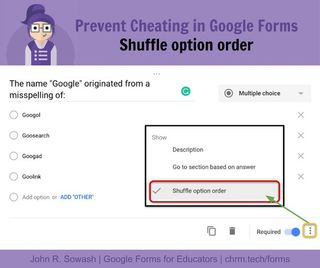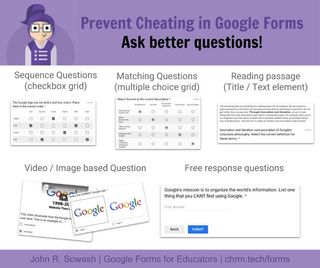
When you purchase through links on our site, we may earn an affiliate commission. Here’s how it works.

If you are using Google Forms to give quizzes and tests in your classroom, you are likely aware that some students have figured out various ways to "game" forms to get a better grade. But you can stop cheating on Google Forms using some of these top tips.
While Google Forms can make a teacher's life easier, in offering a system that allows for quick creation of quizzes, it can also create an opportunity to cheat. That said, if you take the necessary precautions listed below, it's well worth using. For one thing, you can use a vast array of pre-written quizzes and templates, making it easier to set a quiz without taking up lots of prep time.
Before we go into the ways to prevent cheating, be aware of the issue by looking below at some of the ways students try to cheat Google Forms:

When asking a multiple choice question, click on the "snowman" at the bottom right to find the "shuffle option order" feature that will randomize the order of the answer choices in your question.
Shuffling answer choices will make it more difficult for "screen creepers" to copy answers from a classmate.
Note: Google Forms does have a "shuffle question order" feature, however using it can lead to issues. I recommend shuffling answers over shuffling questions.
Tools and ideas to transform education. Sign up below.
By submitting your information you agree to the Terms & Conditions and Privacy Policy and are aged 16 or over.

Add sections to your quiz to prevent students from previewing a form before class. This is a common problem if you post your quiz through Google Classroom to all of your sections early in the day.
You can take this a step further by adding a "password" to your form to prevent students from moving ahead until you are ready.
An easy way to do this is to collect their personal information (name/section) on the first page of the form, but require a password before they can access the quiz question.
Set up a password by adding a short-answer question and using the data validation feature to require a specific number or phrase.
Note: This is not a 100% secure solution and should not be used to protect sensitive information.
Get the latest edtech news delivered to your inbox here:


Google Forms doesn't have a question bank feature to create different assessments for each student. However, you can create a similar experience by creating a branched form.
First, add an ungraded multiple choice question in your quiz: “pick a number,” “pick a color,” etc.
Next, set up 3 to 5 different sections to your quiz using the section feature mentioned in tip #2 above. Add as many questions as you like to each section.
Finally, add a "go-to" rule to direct students to a different section of the based on their response to the ungraded question that you added.

Don't limit yourself to multiple choice questions. By broadening the types of questions you make it more difficult to cheat while at the same time better testing the students' knowledge.
Consider options such as:

Locked quiz mode is one of many tools you have to protect the integrity of your assessments. When used in combination with the tips above, you have done your part to protect the integrity of your classroom quizzes.
Locked mode prevents students from accessing external resources while taking a quiz. Their tabs, extensions, chrome apps, and screenshot functions will be disabled during the duration of the quiz.
You can turn on this feature the settings page on your Google Form OR when assigned through Google Classroom.
If you use some/all of the tips listed above, you have done your part to protect the integrity of your assessments and encourage your students to practice academic honesty.
There is no way to be certain that students can't cheat on an assessment. Ultimately, they are harming themselves and their academic growth. Our job is to encourage, instruct and train them to do their best and show good character, even when they have the opportunity to cheat.